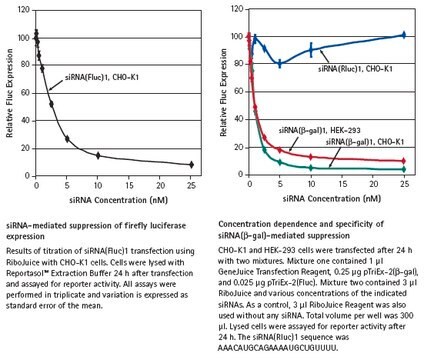L3037
Escort™ III Transfection Reagent
Lipid reagent for transfecting sensitive and primary cells
Se connecterpour consulter vos tarifs contractuels et ceux de votre entreprise/organisme
About This Item
Code UNSPSC :
41106502
Nomenclature NACRES :
NA.25
Produits recommandés
Qualité
for molecular biology
Niveau de qualité
Forme
liquid (aqueous solution)
Utilisation
1 mL sufficient for 250-1000 transfections
Concentration
1 mg/mL
Technique(s)
transfection: suitable
Température de stockage
2-8°C
Description générale
Escort™ III is a unique formulation of a proprietary polycationic lipid and a neutral non-transfecting lipid. This liposome-forming compound is used for transfection of nucleic acids into primary cells.
Application
Suitable for transient and stable transfection of nucleic acids into cultured eukaryotic cells. Use approximately 2-8 μl Escort™ III and 2 μg DNA per 6 cm cell culture plate. Protocol optimization provides very efficient transfection. The following cells have been successfully transfected using Escort™ III:
A549
C2C12 myotubes
Cardiomyocytes (rat)
COS-7
Fibroblasts (rat)
Germ cells (male rat)
Hepatocytes (rat and hamster)
HepG2
HeLa
Jurkat
Keratinocytes (human)
Myoblasts (mouse and quail)
Myocytes (mouse)
NIH3T3
PC-12
Retinal Neurons (rat)
Tracheobronchial cells (sheep)
A549
C2C12 myotubes
Cardiomyocytes (rat)
COS-7
Fibroblasts (rat)
Germ cells (male rat)
Hepatocytes (rat and hamster)
HepG2
HeLa
Jurkat
Keratinocytes (human)
Myoblasts (mouse and quail)
Myocytes (mouse)
NIH3T3
PC-12
Retinal Neurons (rat)
Tracheobronchial cells (sheep)
Caractéristiques et avantages
- Suitable for stable and transient transfection
- Optimized for a wide variety of primary cells
- Low toxicity
- Compatible with both serum and serum-free transfection protocols
- Ideal for PC-12 cells
Composants
Escort™ III formulation:
1 mg/mL total lipid in water
Note the identity of the lipids used in Escort™ III is confidential.
1 mg/mL total lipid in water
Note the identity of the lipids used in Escort™ III is confidential.
Attention
Do not freeze.
Principe
A stable complex is formed when Escort™ III is mixed with DNA in the absence of serum. The complexes are stable and can be directly added to the cell culture medium, where they fuse with the cell membrane, releasing the DNA into the cytoplasm. Note: complex formation is inhibited by serum, but once stable complexes have formed, the presence of serum is without consequence.
Informations légales
Escort is a trademark of Sigma-Aldrich Co. LLC
Produit(s) apparenté(s)
Réf. du produit
Description
Tarif
Code de la classe de stockage
10 - Combustible liquids
Classe de danger pour l'eau (WGK)
WGK 3
Point d'éclair (°F)
Not applicable
Point d'éclair (°C)
Not applicable
Équipement de protection individuelle
Eyeshields, Gloves
Certificats d'analyse (COA)
Recherchez un Certificats d'analyse (COA) en saisissant le numéro de lot du produit. Les numéros de lot figurent sur l'étiquette du produit après les mots "Lot" ou "Batch".
Déjà en possession de ce produit ?
Retrouvez la documentation relative aux produits que vous avez récemment achetés dans la Bibliothèque de documents.
Les clients ont également consulté
Patrick Orth et al.
Molecular biotechnology, 38(2), 137-144 (2008-01-26)
The aim of the present study was to evaluate the efficacy of novel nonviral gene delivery systems in cells of musculoskeletal origin. Primary cultures of lapine skeletal muscle cells, lapine articular chondrocytes, human cells from fibrous dysplasia and cell lines
Tomás C O'Riordan et al.
American journal of physiology. Regulatory, integrative and comparative physiology, 292(4), R1613-R1620 (2006-12-16)
The development and application of a methodology for measurement of oxygen within single mammalian cells are presented, which employ novel macromolecular near infrared (NIR) oxygen probes based on new metalloporphyrin dyes. The probes, which display optimal spectral characteristics and sensitivity
Thomas Iskratsch et al.
The Journal of cell biology, 191(6), 1159-1172 (2010-12-15)
Members of the formin family are important for actin filament nucleation and elongation. We have identified a novel striated muscle-specific splice variant of the formin FHOD3 that introduces a casein kinase 2 (CK2) phosphorylation site. The specific targeting of muscle
Lixian Liu et al.
Frontiers in cell and developmental biology, 9, 634242-634242 (2021-03-12)
The mitogen-inducible gene 6 (MIG6) is an adaptor protein widely expressed in vascular endothelial cells. However, it remains unknown thus far whether it plays a role in angiogenesis. Here, using comprehensive in vitro and in vivo model systems, we unveil
Inmaculada Navarro-Lérida et al.
Journal of cell science, 117(Pt 9), 1687-1697 (2004-04-13)
Several cell types express inducible nitric oxide synthase (NOS2) in response to exogenous insults such as bacterial lipopolysaccharide (LPS) or proinflammatory cytokines. For instance, muscular cells treated with LPS and interferon gamma (IFN-gamma) respond by increasing the mRNA and protein
Notre équipe de scientifiques dispose d'une expérience dans tous les secteurs de la recherche, notamment en sciences de la vie, science des matériaux, synthèse chimique, chromatographie, analyse et dans de nombreux autres domaines..
Contacter notre Service technique











